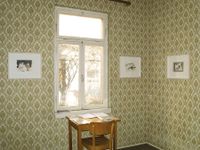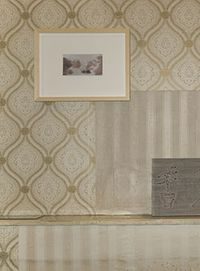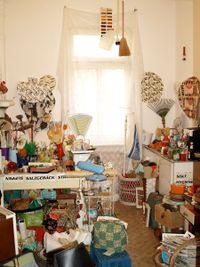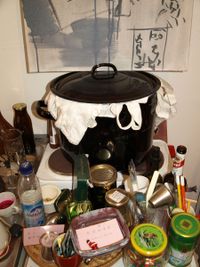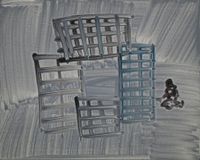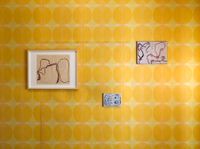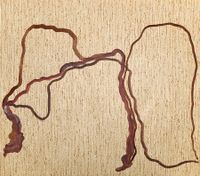Return to Go, 2010
HOME ABROAD
Frankfurt am Main
“You say ‘the handkerchief, but which handkerchief. The handkerchief used to cry into, the
one you use to wave goodbye is not the one you use to dress a wound, and not the one you use
to blow your nose, when you have a cold, and not the one you tie knots in so as to remember
something, and not the one you put money inside so as not to lose it, and not the one lying at
the side of the street because someone lost it or threw it away. Handkerchiefs are never one
and the same. How many unspoken possibilities are there in the simple sounding sentence:
‘The woman put her handkerchief away’.” (1)
The meaning of an object evolves within the context in which it is experienced. The meaning
lies in the use someone makes of it. For example, when he looks at it. Or when he ignores it.
Or when he looks for words for this object. The first object encountered by the visitor to the
exhibition Return to go by Christiana Protto is a smallish house in Frankfurt Sachsenhausen,
in which the artist initiative Home Abroad rented an apartment for exhibition purposes and
other cultural events. This house is smaller than the surrounding buildings and compared with
them it presents an older face – somewhat dilapidated, somewhat neglected. It has a mournful
charm all of its own.
For Christiana Protto’s work it is essential to infuse the venue she is exhibiting and working
in with meaning without taking possession of it, be it the corridors of the regional finance
office in Frankfurt/Main, the Essen-Huttrop cemetery, the premises of the Wiesbaden
Kunstverein or the onetime rooms in that house in Frankfurt Sachsenhausen. Precisely
because she does not attempt to alter the specific character of the place, she lends it the
meaning that befits it so that it is involved in the respective work, indeed, can be seen as part
of it. Consequently, the individual works are presented in the said apartment, where they enter
into a special relationship structure with the existing surroundings and without losing their
autonomy they become an integral work with the setting: Return to go.
Christiana Protto’s work always stands in the context of experienced life but without
renouncing its own self-determination. That is the fascinating principle of this art. It is about the interplay of the divergent. Working in the context of experienced life means adopting a critical stance towards both individual and cultural given interpretations. In the process, each person has to be allowed their own individual use of the artwork, leaving it to the observer to arrive at his own meanings of the work. The observer of Return to go enters an apartment,
which is almost entirely in the state it was left by the previous tenant. As such, the wallpaper
on the walls tells of bygone fashions, and Christiana Protto has them become involved in her
presentation. The wallpaper represents fragmentary texts of a life, a life about whose nature
we know nothing. It does not occur to Christiana Protto to tell stories.
In the first room, called the “green room”, there are framed works by Protto on a wallpaper with an ornamental floral pattern. The works are from the series Tao Ke Rui’s Diaries, and “Tao Ke Rui” is a transcription of the artist’s name into Chinese. Diaries serve self-
understanding, comprehending your own self, your own identity. They are essentially private.
Christiana Protto’s diaries were recorded during a six-month stay – for work and studies in China, in 2007. The alien culture, the divergent became a place of self-understanding. We see a layer of graphics, recognize Chinese characters and words in our Western Latin writing, together with lines. The material in question comes from a specific experience, in this instance from the sphere of learning Chinese. What is decisive is not the meaning of individual characters or words but the relationship to the superincumbent painting, which is sometimes calligraphically reduced and figurative, other times flowing. It is about an easy relationship of what is diametrically opposed: graphically controlled structure and painterly expression. The room with its window and its wallpaper underscores the light and calm breath of these works, which is perhaps the breath of an old alien culture, perhaps the breath of the artist. At any rate it is also the character of this room.
In the small white painted kitchen Christiana Protto has installed one of her traveling studios: a compact collection of items. The latter are seemingly natural objects, which ended up in the artist’s possession and which she carefully selected and arranged. The traveling studio can be observed from the entrance – like a painting. But the observer can also enter and discover ever
new objects, identify connections of a formal and topical nature, perhaps make biographical
connections to certain objects or find mysterious things whose use and meaning he cannot
fathom. As an artistic concept the “traveling studio” is a work of free exploration for the observer, while for the artist it represents a precisely determined composition of objects. In
the “traveling studio” the work materials are simultaneously the content of the exhibition. The
condensation of objects produces shifts and overlaying of meanings. As a place of artistic work the studio is not bound to a specific room, but takes place in the respective location. The artist moves with her studio: It is in that place where she lives and works. And simultaneously a transformation of the functional room into an exhibition takes place. Here, too, we are dealing with lived life.
The ‘wandering’ of the migrant represents a specific attitude to life. Unlike someone strolling
the wanderer does not walk through countryside in calm contemplation. He moves from one place to another. He returns, only to set off again. Life as an ongoing journey means
incorporating leave-taking and the new into your personal biography: and indeed, every
moment we take leave of experienced life and leave behind our own fragmentary texts. Or we
collect them like Christiana Protto.
In the hallway there is a shelf, higher up, that was perhaps once used to store a suitcase, a
further station of the traveling studio. The observer might experience the arrangement here to be more arbitrary than in the kitchen as is this were something left behind by the previous tenant. In this meshing of the real and the staged a further structure of individual biography
becomes visible: Is it orchestrated in the memory or the reproduction of onetime reality?
Which new means of interpretation result from our experienced meaning, our own use of things? What do we know about our meanings?
There are three additional rooms in which the artist in the choice and hanging of the works
created in 2010 works with the special character of the rooms, which is fundamentally shaped
by the old wallpaper. In the “drawing room”, the largest and most austere of the rooms the
observer encounters landscapes and plants in which the painting has assumed a greater
sumptuousness, yet strangely enough comes over itself like an abstract sign. In the “sun room”
with its visually tiring yellow wallpaper this optical imposition is softened by garden images.
The ornamental in nature conceals the exact geometry of the wallpaper pattern – supported by the playful hanging. The most serious room in Return to go is the “heart room”. Once again the name was given on account of the wallpaper pattern. But in this exhibition the designation can also be seen metaphorically: it is as if the observer had reached the heart of the things, as if the issue were the direct encounter with human intellectual nature in all its ambivalence.
We humans determine the attitude we take, the importance we accord our lives. From the
“heart room” there is no passage back to the apartment. The tour does not come to an end. The
observer returns. Perhaps he returns to the beginning.
(1) Herta Müller, Der König verneigt sich und tötet, special edition (Frankfurt/Main, 2010)
[Munich/Vienna 2003], p. 108.
Angelica Horn
Within the context of experienced life, in:
Christiana Protto – Return to Go and other options,
Frankfurt am Main, 2011
© Angelica Horn
